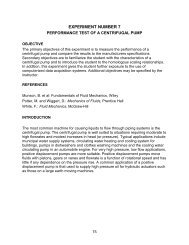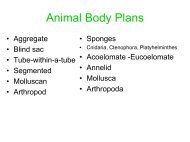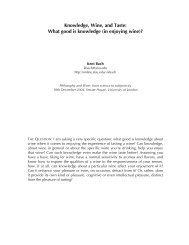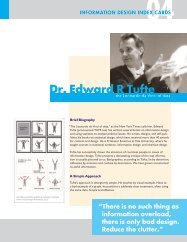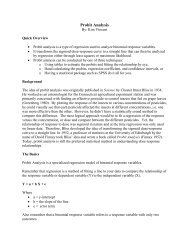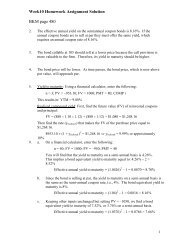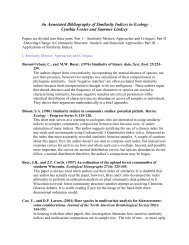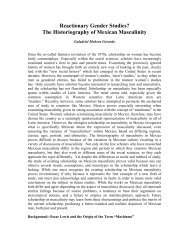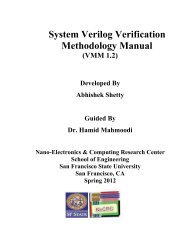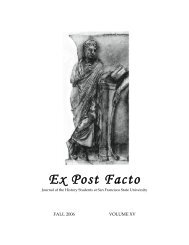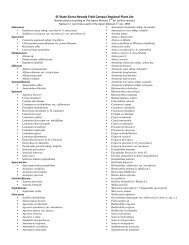Molecular Phylogeny of the Chipmunks Inferred from Mitochondrial ...
Molecular Phylogeny of the Chipmunks Inferred from Mitochondrial ...
Molecular Phylogeny of the Chipmunks Inferred from Mitochondrial ...
Create successful ePaper yourself
Turn your PDF publications into a flip-book with our unique Google optimized e-Paper software.
346 PIAGGIO AND SPICER<br />
TABLE 5<br />
Revised Classification <strong>of</strong> <strong>Chipmunks</strong> Based on cyt b<br />
<strong>Molecular</strong> Sequences<br />
Genus Tamias—includes only Tamias striatus<br />
Genus Eutamias—includes only Eutamias sibiricus<br />
Genus Neotamias—includes five species groups<br />
N. amoenus species group—includes only N. amoenus<br />
N. quadrivittatus species group—includes N. quadrivittatus, N.<br />
rufus, N. durangae, N. bulleri, N. canipes, N. dorsalis, N.<br />
umbrinus (syn. N. palmeri), and N. cinereicollis<br />
N. merriami species group—includes N. merriami and N.<br />
obscurus<br />
N. minimus species group—includes N. minimus, N. ruficaudus,<br />
N. panamintinus, and N. quadrimaculatus<br />
N. townsendii species group—includes N. townsendii, N. senex,<br />
N. sonomae, N. siskiyou, and N. ochrogenys<br />
graphic distributions <strong>of</strong> clades, and specify <strong>the</strong> taxa<br />
that belong in each genus and species group (Table 5).<br />
Systematics <strong>of</strong> species groups. The genus Neotamias<br />
represents an amazing example <strong>of</strong> adaptive radiation<br />
in <strong>the</strong> western United States and many authors<br />
have sought to untangle <strong>the</strong> systematics <strong>of</strong> <strong>the</strong>se taxa.<br />
The COII phylogeny (Piaggio and Spicer, 2000) resolved<br />
some <strong>of</strong> <strong>the</strong> taxonomic problems, but several<br />
still remained within this group. The COII data set did<br />
not include all <strong>the</strong> taxa that are included in <strong>the</strong> current<br />
analysis <strong>of</strong> <strong>the</strong> mitochondrial cyt b gene, in particular,<br />
N. ochrogenys and N. siskiyou <strong>of</strong> <strong>the</strong> N. townsendii<br />
clade and N. minimus consobrinus <strong>of</strong> <strong>the</strong> N. minimus<br />
clade. These taxa help to clarify taxonomic relationships<br />
that have previously been debated. Although our<br />
analyses demonstrated that <strong>the</strong> relationships among<br />
<strong>the</strong> clades are not resolved, <strong>the</strong> clades (species groups;<br />
Table 5) remain intact regardless <strong>of</strong> <strong>the</strong> model applied<br />
to <strong>the</strong> data. Therefore, it is important to examine <strong>the</strong>se<br />
species groups in detail and in regard to species groups<br />
designated previously by o<strong>the</strong>r authors.<br />
The cyt b sequences <strong>of</strong> N. ochrogenys and N. siskiyou<br />
were added to <strong>the</strong> cyt b data set to provide resolution <strong>of</strong><br />
<strong>the</strong> relationships <strong>of</strong> <strong>the</strong>se species to <strong>the</strong> N. townsendii<br />
species group. Adams and Sutton (1968) concluded<br />
that N. townsendii ochrogenys had a baculum distinct<br />
<strong>from</strong> that <strong>of</strong> N. townsendii and suggested that this<br />
distinction warranted species differentiation. Sutton<br />
and Nadler (1974) analyzed bacular morphology <strong>of</strong><br />
three subspecies <strong>of</strong> N. townsendii: N. t. ochrogenys, N.<br />
t. senex, and N. t. siskiyou. They concluded that <strong>the</strong>se<br />
subspecies should be elevated to <strong>the</strong>ir own species.<br />
Levenson and H<strong>of</strong>fmann (1984) analyzed electrophoretic<br />
data and determined that <strong>the</strong> species N.<br />
ochrogenys, N. senex, and N. siskiyou should not be<br />
elevated to species status, despite <strong>the</strong> findings <strong>of</strong> Sutton<br />
and Nadler (1974). A year later, Kain (1985) analyzed<br />
morphological and biochemical data <strong>of</strong> <strong>the</strong> N.<br />
townsendii group and decided that N. ochrogenys and<br />
N. senex should be retained as separate species. Finally,<br />
Sutton (1987) analyzed various data, including<br />
biogeography and morphology, and once again concluded<br />
that <strong>the</strong> data supported <strong>the</strong> classification <strong>of</strong> N.<br />
ochrogenys, N. senex, and N. siskiyou as distinct species.<br />
Our cyt b molecular data indicate that N. ochrogenys<br />
is a distinct lineage (Fig. 4) within <strong>the</strong> N. townsendii<br />
group. N. senex also appears to be a distinct lineage<br />
(Fig. 4) and, finally, N. siskiyou groups with <strong>the</strong> N.<br />
townsendii group as a distinct lineage and is <strong>the</strong> most<br />
basal taxon in this clade. Therefore, our analyses support<br />
<strong>the</strong> designation <strong>of</strong> <strong>the</strong>se taxa as species.<br />
Within <strong>the</strong> N. minimus clade, previous phylogenetic<br />
analyses have indicated paraphyletic relationships<br />
among <strong>the</strong> subspecies. In particular, in some data sets<br />
N. m. operarius and N. m. consobrinus have appeared<br />
to group outside <strong>of</strong> <strong>the</strong> rest <strong>of</strong> <strong>the</strong> N. minimus taxa<br />
(White, 1953b; Nadler et al., 1969, 1977, 1985; Sutton<br />
and Nadler, 1969; Levenson et al., 1985). We demonstrated<br />
in our COII phylogeny that N. m. operarius<br />
(Colorado) formed a monophyletic relationship with<br />
<strong>the</strong> rest <strong>of</strong> <strong>the</strong> N. minimus species plus N. panamintinus<br />
and N. quadrimaculatus (Piaggio and Spicer,<br />
2000). In <strong>the</strong> current analysis <strong>of</strong> cyt b, we have also<br />
included T. m. consobrinus (Utah) and again we find a<br />
monophyletic relationship among <strong>the</strong> six N. minimus<br />
taxa, N. panamintinus, and N. quadrimaculatus<br />
(Fig. 1).<br />
The N. minimus clade reveals o<strong>the</strong>r surprises. Our<br />
cyt b (Figs. 1 and 3) and COII (Piaggio and Spicer,<br />
2000) data place N. ruficaudus and N. quadrimaculatus<br />
in <strong>the</strong> N. minimus clade. It is unexpected to find N.<br />
quadrimaculatus grouping in this clade because it has<br />
always been placed in <strong>the</strong> N. townsendii species group.<br />
It is also ra<strong>the</strong>r surprising that <strong>the</strong> larger-sized chipmunks<br />
N. ruficaudus and N. quadrimaculatus are<br />
closely related to <strong>the</strong> diminutive N. minimus. However,<br />
morphological and external characters in Neotamias<br />
appear to reflect environmental conditions ra<strong>the</strong>r than<br />
phyletic relationships in chipmunks. Patterson (1980b,<br />
1981, 1982) found correlation between morphological<br />
shifts and niche shifts and concluded that <strong>the</strong>re is<br />
convergence <strong>of</strong> morphological and external characters,<br />
which is driven by competition and environment.<br />
Later, Patterson (1983) found correlation between cranial<br />
and mandibular characters; mandibular characters<br />
are known to be influenced by environmental factors.<br />
Therefore, if traditional morphological characters<br />
do not approximate <strong>the</strong> evolutionary history among<br />
<strong>the</strong>se taxa, <strong>the</strong>n <strong>the</strong> sizes <strong>of</strong> <strong>the</strong>se animals may be due<br />
to <strong>the</strong>ir ecological niches and to convergence.<br />
Distribution patterns. Our molecular phylogenies<br />
(Figs. 1–4) suggest five distinct clades within <strong>the</strong> genus<br />
Neotamias. We consider <strong>the</strong>se clades equivalent to<br />
species groups. These species groups appear to correspond<br />
to <strong>the</strong> geographical ranges <strong>of</strong> <strong>the</strong> taxa (Fig. 6).



